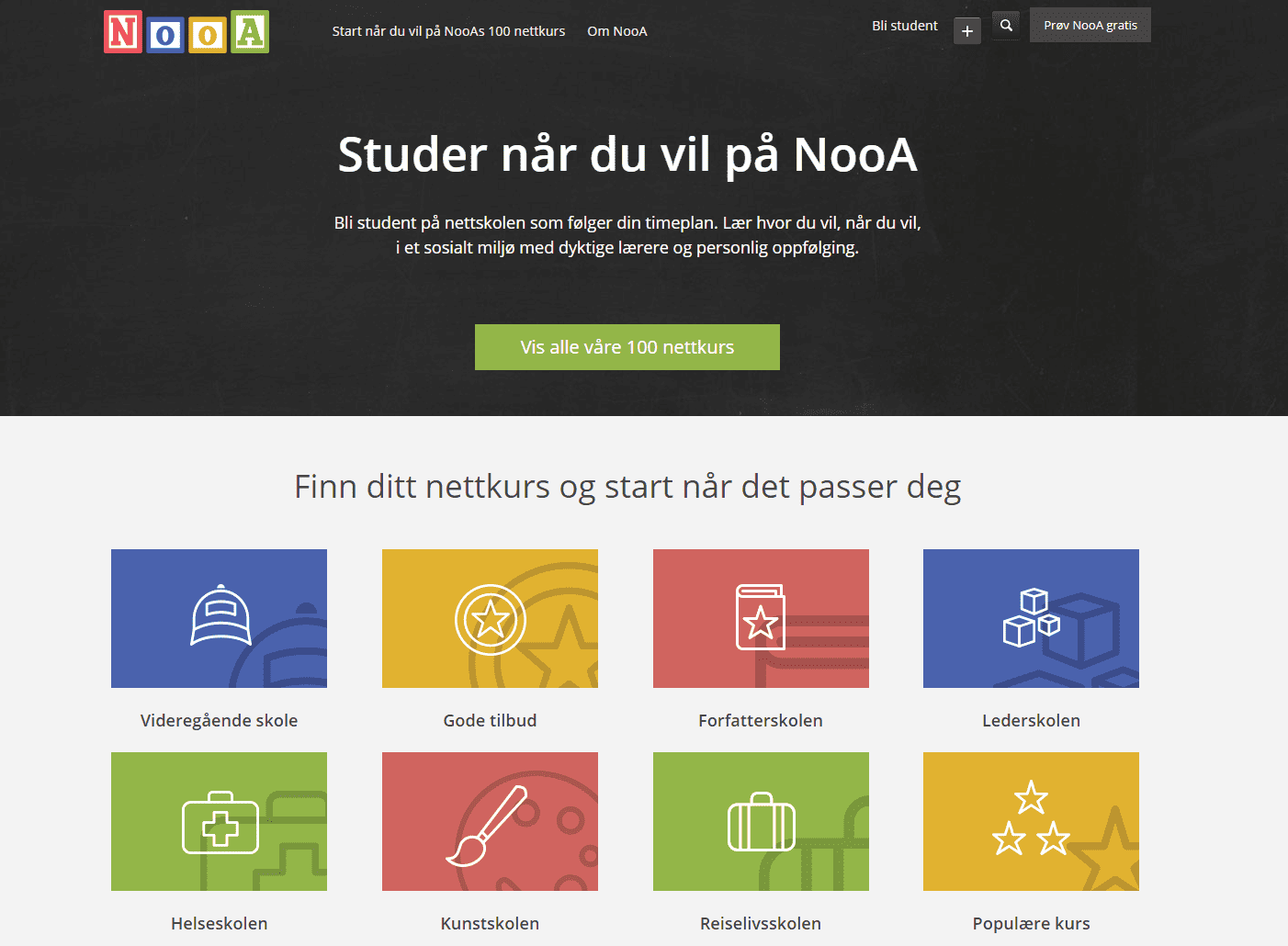Professor of online education: Online education is more than webinars, conferences and video lectures

The training industry is constantly evolving, and input and experience from experts in the field is more important than ever to stay up-to-date! We spoke with a professor of online education, Morten Flate Paulsen. Morten became Europe’s first online teacher in 1986, and has a doctorate in teaching techniques for online communication, has been the development leader for NKI online studies, president of the European distance and e-learning network (EDEN). Secretary General of the International Council for Open and Distance Education (ICDE), and last but not least is the founder of NooA (Nordic Open Online Academy). Keep on reading to get his advice for conducting great, online courses, tips for educational adjustments online and how you should market your online courses!

About NooA
- Founded in 2012
- Cloud-based course service
- Is a marketplace for online courses with several online schools and over 1000 users in 20 countries
- Built on a basic idea of flexibility when it comes to courses and education
- Developed online courses with course providers in several countries that are delivered in several languages through the Authors’ School, the Tourism School, the Leadership School, the Health School, the Art School and the Upper Secondary School
NooA is an online school established in 2012 that is based on cloud services. This is a school different from other schools, where students and course participants manage their own schedule.
“We want to be different from other schools, by being as flexible in time as possible. This means that students can start our courses at any time, and take the time they need, study when and where they want during the week. There should be no fixed submission deadlines or fixed meeting times, considering that it should be so flexible that people who work shifts or are taking care of children and families can study when it suits them, and not when it suits the school.”
NooA’s vision is clear and distinct – to offer flexible courses that make it possible for more people to study
“This way of conducting education makes it possible for many people who otherwise do not have the opportunity to study, to get an education and get on in the world. It is either because they live in a place where there is no education possibilities, or that they have jobs and kids to take care of that mean they do not have time to study. So I found that technology helped many people with different kinds of challenges, to realize their dreams.
I saw that there were many online students who struggled with social anxiety or different types of disabilities. And that young mothers often dropped out of school. People with those kinds of challenges can get through an education via flexible online studies.”
Morten believes that flexibility should be central to online courses and education.
I asked my master’s students in e-learning course at NTNU and asked: “Do you prefer streaming TV or linear TV?”. Ninety-five percent raise their hand and say they prefer streaming TV. Then I ask the question: “Do you prefer linear school or streaming school?”.
And then they look at each other, because they have never heard of streaming school. And then we get an interesting discussion, because why should I not be able to read the entire syllabus on the couch on Saturday, Sunday and Monday? Why do I have to show up for a lecture at that and that time? Why do I have to submit the answer on this and this date? Why is it only possible to take an exam one day?
And what I am trying to convey is that education must try to be as flexible as other streaming services are. We should be able to deliver all the teaching services to the students when it suits them, in the order and pace that suits them.
The key factors in running successful online courses
As a professor of online education at NTNU, development manager for NKI online studies and no less than Europe’s first online teacher in 1987, Morten has gained some experience when it comes to online courses. He believes the key factors in running successful online courses are getting the most out of the resources you have available and thinking in new ways.
“I am interested in developing course content that can be reused many times. So if you think about what is happening in these corona times, there are a lot of traditional educational institutions that have suddenly thrown themselves around and created online teaching programs. These are in many cases a copy of the classroom-based teaching with a lot of video conferences, video lectures and webinars. And that is natural, because that is the kind of teaching they know. But it is not the most sensible way to conduct rational and cost-effective online education.
So I am sometimes a little frustrated to see that there are so many who have discovered online education now with all the webinars and video conferences. Because there is so much more to it! And so much more that might work better.”
Morten also has some tips for those who have now started to deliver education online for the first time.
“I would recommend those who are going to switch to online teaching to think in new ways, and not just try to copy or duplicate the classroom-based teaching to the online platform. But to see that the web has other possibilities, which one could consider using. Maybe other forms of tasks, maybe more flexibility in time? So to simply free yourself a little from the pedagogical model you have used in traditional teaching and think “can I take advantage of the fact that the web has other possibilities than what a classroom has?”.
Pedagogical adjustments for online teaching
It is not only technical adjustments that should be made when going from classroom to online teaching, pedagogical adjustments are also necessary.
“One thing is that the time attention span online is less than what you usually assume it is in the classroom. So you have to create smaller learning objects that may take less time to get through. So instead of having a 45 minute video lecture, you can have several shorter snippets.
Another part of it is that once you are online, you suddenly have access to a whole lot of resources that are outside your classroom or your school. You can encourage students to contact someone who has relevant work experience in what you are studying. Or invite students to do a short interview with one or another professional within the topic. And you can very easily create micro-lectures where you can get an expert from anywhere in the world to talk for 15 minutes about what they are interested in.
You are also not bound to the teacher or the participants in the course. You can open up to draw in resources, both people, links and lots of services because it’s online! And getting teachers or instructors to raise their gaze and think that the horizon is so much bigger, it can contribute to lots of exciting tasks!”
NooA now has over 5000 users and 150 courses, but it varies a lot which courses are popular and Morten therefore thinks it is wise to have several different courses.
It is good to have many courses and not put all your eggs in one basket. Because in some periods there are some courses that are popular, and in other periods there are others. So I see it as a necessity to have more courses and that allows us to withstand downturns in some areas, because there are others that go up. And we have become more selective over time because we made a number of courses that became deadstock.
And of course some courses are bestsellers, others sell ok, while some don’t sell that much. But we have a large selection, and we want to expand with even more. Although we must constantly collaborate with people who have the expertise and preferably people who want to convert classroom-based courses to online courses, and people who have a brand name or already have students. That is an excellent partner in our eyes!
Important marketing channels; NooA’s websites and Kursguiden.no
Popular courses give any course business a boost, but marketing is also an important component when it comes to getting course participants to book in. Morten mentions several marketing channels that work well when marketing courses.
“The most important channel for NooA is our website, as it is quite extensive. We have around 150 courses that it is possible to sign up for today. And all the courses have a course description because we have worked a lot with search engine optimization on each course. What we have spent the most time, effort and resources on, is creating a webpage that is highly visible in search engines.
We have also tried to be active on social media, and for us it’s probably Facebook that works best. We have spent more time and effort using social media than advertising on it. But we spend a lot of money on Facebook ads.
We have also used Kursguiden.no and similar services such as Utdanning.no for example, which are services where we can enter information about our courses. And we have experimented with several other of the catalogs as well, but Kursguiden.no gives us a lot of traffic compared to many other sites. In addition, we send out newsletters to the 5,000 users in our learning platform. We have also received some positive reviews in various media, and there are also absolutely positive contributions!”
If you want to learn more about why a good course description is important, read our 13 tips on course descriptions that give you more participants!
Learn from those with experience in online education!
The changes that have taken place during 2020 have led to many of the educational institutions having to throw themselves over virtual teaching, but perhaps not in the most optimal way.
“What I’m afraid of is that they think the way they do it is the best. But those who have been doing this for 10-20 years and have experience in the field may not be seen and heard. And those experiences are a bit overlooked when the new wave of vendors arrives. They are used to doing it the way it has been done in regular classrooms, and think that is the way to do it. While I would encourage everyone to try to gain experience from previous online schools, and take advantage of the experience that has been gained. I’m a little afraid that a lot of it will be forgotten in the period we are in now.”
If more course providers are interested in getting better at online courses and education, Morten has some tips on who to follow.
“I would say that one should look at the work and the members that Fleksibel utdanning Norge (Flexible Education Norway) has. It is an industry organization that has organized many of those who have been concerned with online education and distance learning for a number of years. They have in their network, their publications and in their membership many talented people who may be able to contribute.”
Did you like this article? Don't forget to share it:
About FrontCore
Over 3700 training providers use solutions from FrontCore – and that’s not without reason. FrontCore is one of Norway’s leading competence environments within cloud based systems for Training Management, Learning Management and Webmarketing. With over 23 years of experience from the training industry and our finger on the market pulse continuously, we help course and training providers achieve more efficiency and higher revenue.
Get your tasks done with Checklist Template for Courses
Products


Related articles
The Phillips ROI model explained: Key to any training provider
Want to show the true value of your training programmes? Learn how the Phillips ROI model helps you measure learning outcomes, business impact — and real ROI. A must-know for any serious training provider!
Guide: How to start a training business
Thinking of starting your own training company in the UK? Get all the essential steps, insights, and expert tips in this complete guide—plus how the right tools can help you succeed from day one. Ready to launch your training business?
Kirkpatrick model: How to use it in your training business
Curious about how to measure your training’s true impact? Discover how the Kirkpatrick Model can help you improve your courses, boost participant satisfaction, and achieve real business results.








0 Comments